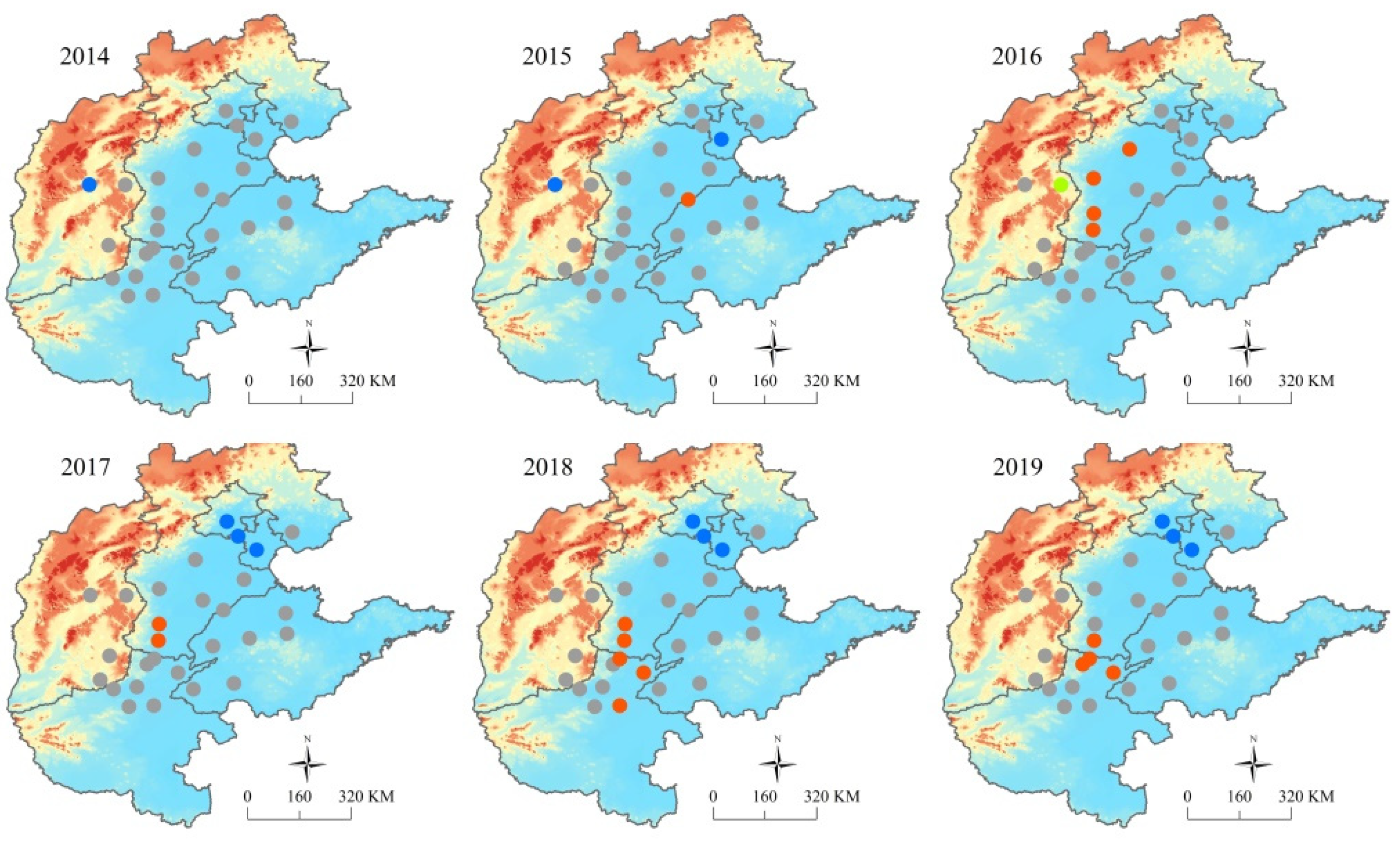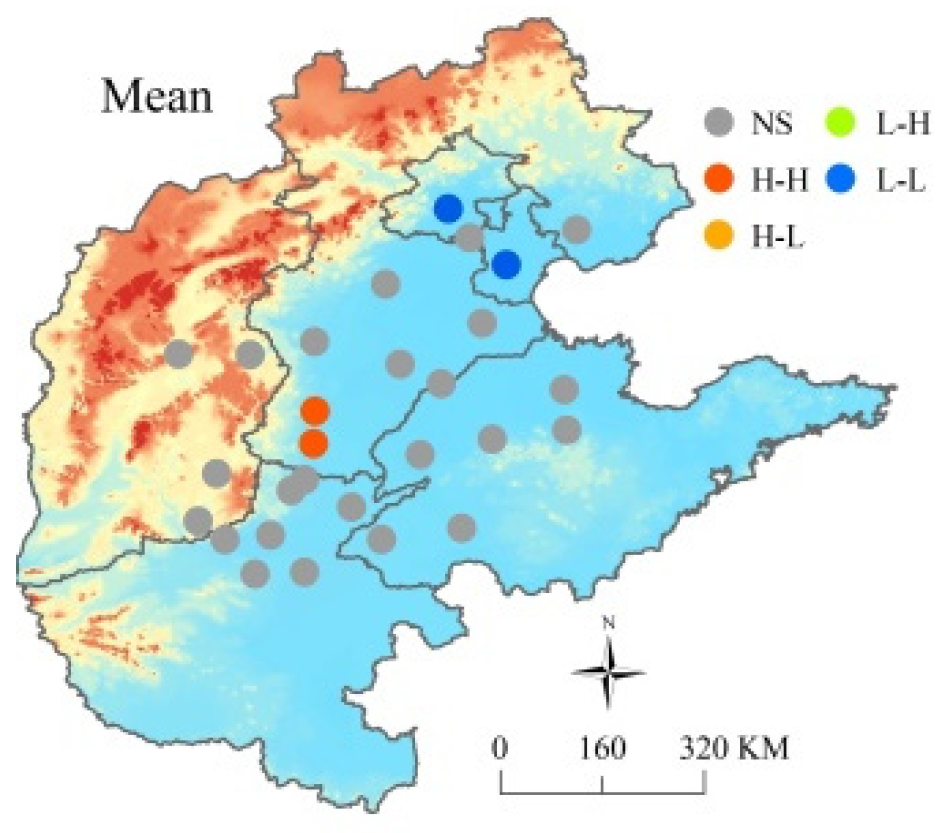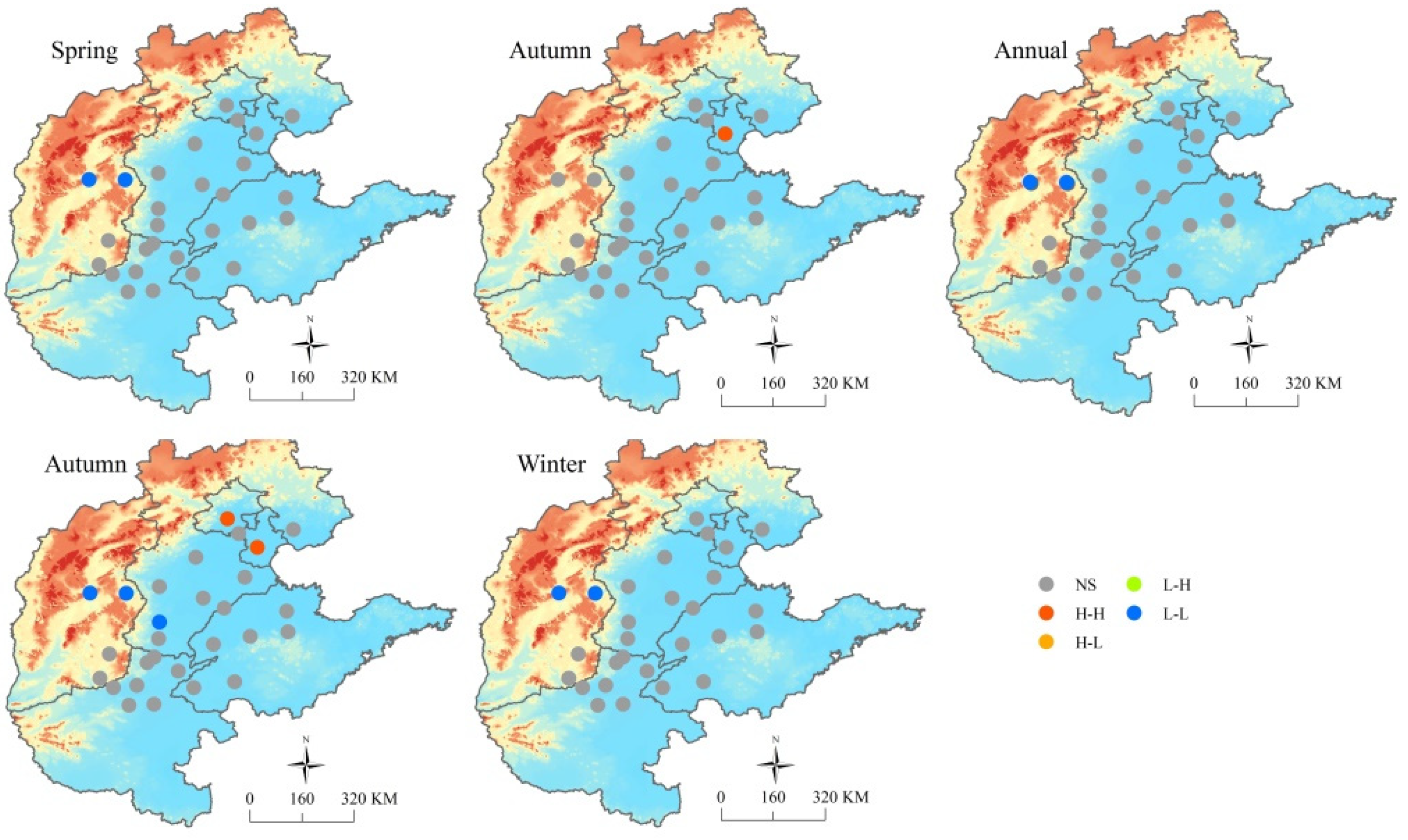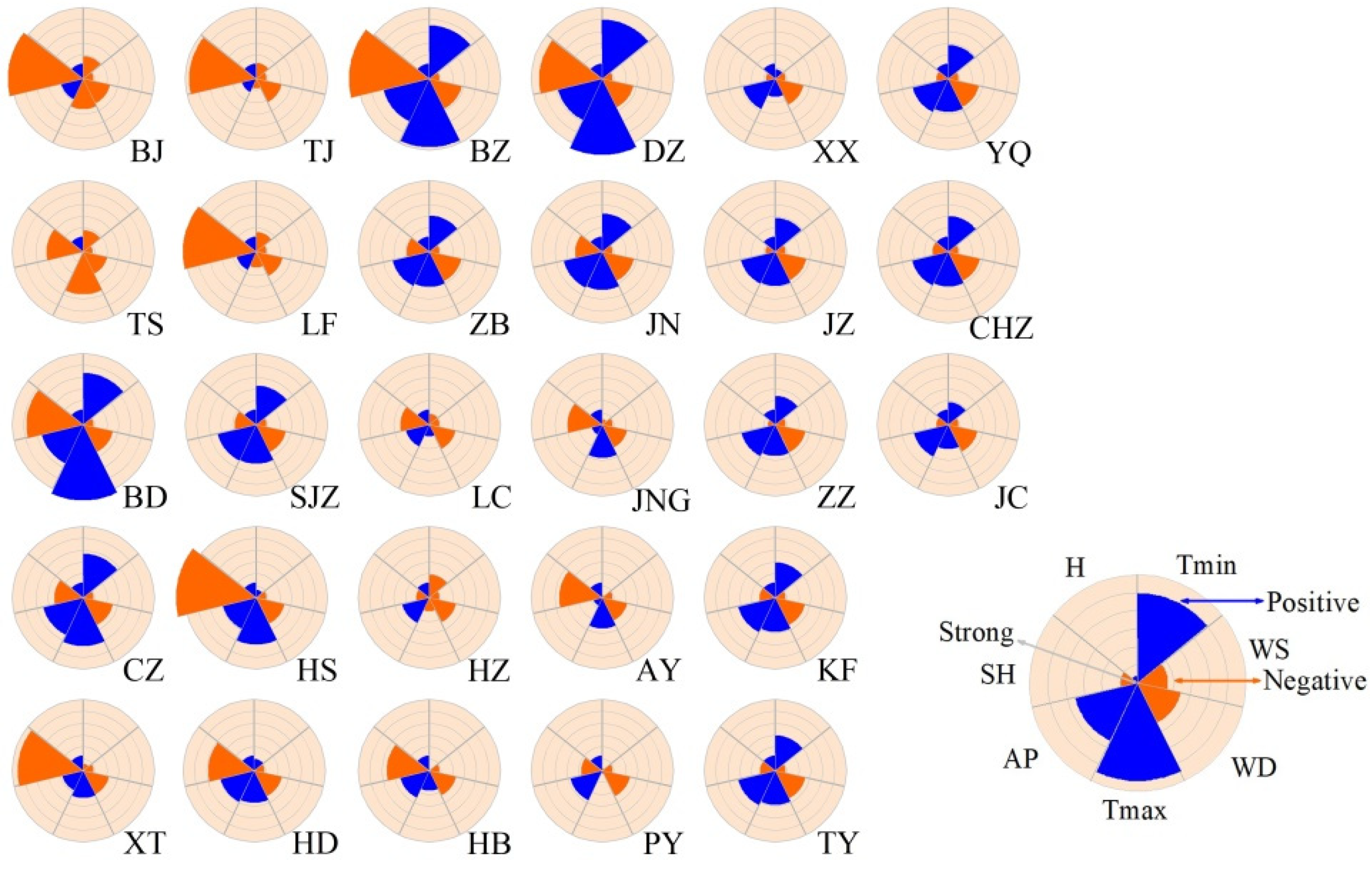Meteorological Influences on Spatiotemporal Variation of PM2.5 Concentrations in Atmospheric Pollution Transmission Channel Cities of the Beijing–Tianjin–Hebei Region, China
Abstract
:1. Introduction
2. Materials and Methods
2.1. Study Area
2.2. Data Sources
2.3. Methods
2.3.1. Spatial Autocorrelation and Linear Regression
2.3.2. Partial Correlation and Multiple Linear Regression
2.3.3. Geographically Weighted Regression
3. Results
3.1. Overview of PM2.5 Pollution
3.1.1. Spatiotemporal Variation of PM2.5
3.1.2. Distribution of PM2.5/PM10 Ratios
3.2. Relationships between Temporal PM2.5 Variation and Meteorological Variables
3.3. Effects of Meteorological Factors on the Spatial Heterogeneity of PM2.5
4. Discussion
4.1. Spatiotemporal Variations in PM2.5
4.2. Relationship between PM2.5 Concentration and Meteorological Factors
5. Conclusions
Supplementary Materials
Author Contributions
Funding
Institutional Review Board Statement
Informed Consent Statement
Data Availability Statement
Conflicts of Interest
References
- Orellano, P.; Reynoso, J.; Quaranta, N.; Bardach, A.; Ciapponi, A. Short-term exposure to particulate matter (PM10 and PM2.5), nitrogen dioxide (NO2), and ozone (O3) and all-cause and cause-specific mortality: Systematic review and meta-analysis. Environ. Int. 2020, 142, 105876. [Google Scholar] [CrossRef] [PubMed]
- Wang, X.; Dickinson, R.E.; Su, L.; Zhou, C.; Wang, K. PM2.5 pollution in China and how it has been exacerbated by terrain and meteorological conditions. Bull. Am. Meteorol. Soc. 2018, 99, 105–119. [Google Scholar] [CrossRef]
- Zhang, Q.; Zheng, Y.; Tong, D.; Shao, M.; Wang, S.; Zhang, Y.; Xu, X.; Wang, J.; He, H.; Liu, W. Drivers of improved PM2.5 air quality in China from 2013 to 2017. Proc. Natl. Acad. Sci. USA 2019, 116, 24463–24469. [Google Scholar] [CrossRef] [PubMed] [Green Version]
- Ding, A.; Nie, W.; Huang, X.; Chi, X.; Sun, J.; Kerminen, V.-M.; Xu, Z.; Guo, W.; Petäjä, T.; Yang, X.; et al. Long-term observation of air pollution-weather/climate interactions at the SORPES station: A review and outlook. Front. Environ. Sci. Eng. 2016, 10, 15. [Google Scholar] [CrossRef]
- Huang, Y.; Yang, X. Influence of fine particulate matter on atmospheric visibility. Chin. Sci. Bull. 2013, 58, 1165–1170. (In Chinese) [Google Scholar] [CrossRef]
- Wang, X.; Zhang, R.; Yu, W. The Effects of PM2.5 Concentrations and Relative Humidity on Atmospheric Visibility in Beijing. J. Geophys. Res. Atmos. 2019, 124, 2235–2259. [Google Scholar] [CrossRef]
- Grell, G.; Freitas, S.R.; Stuefer, M.; Fast, J. Inclusion of biomass burning in WRF-Chem: Impact of wildfires on weather forecasts. Atmos. Chem. Phys. 2011, 11, 5289–5303. [Google Scholar] [CrossRef] [Green Version]
- Wang, Z.; Zhang, H.; Lu, P. Improvement of cloud microphysics in the aerosol-climate model BCC_AGCM2.0.1_CUACE/Aero, evaluation against observations, and updated aerosol indirect effect. J. Geophys. Res. Atmos. 2014, 119, 8400–8417. [Google Scholar] [CrossRef]
- Song, Y.; Qi, Z.; Zhang, Y.; Wei, J.; Liao, X.; Li, R.; Dong, C.; Zhu, L.; Yang, Z.; Cai, Z. Effects of exposure to ambient fine particulate matter on the heart of diet-induced obesity mouse model. Sci. Total Environ. 2020, 732, 139304. [Google Scholar] [CrossRef]
- Yao, Y.; Pan, J.; Wang, W.; Liu, Z.; Kan, H.; Qiu, Y.; Meng, X.; Wang, W. Association of particulate matter pollution and case fatality rate of COVID-19 in 49 Chinese cities. Sci. Total Environ. 2020, 741, 140396. [Google Scholar] [CrossRef]
- Fang, D.; Wang, Q.; Li, H.; Yu, Y.; Lu, Y.; Qian, X. Mortality effects assessment of ambient PM2.5 pollution in the 74 leading cities of China. Sci. Total Environ. 2016, 569–570, 1545–1552. [Google Scholar] [CrossRef] [PubMed]
- Cohen, A.J.; Brauer, M.; Burnett, R.; Anderson, H.R.; Frostad, J.; Estep, K.; Balakrishnan, K.; Brunekreef, B.; Dandona, L.; Dandona, R.; et al. Estimates and 25-year trends of the global burden of disease attributable to ambient air pollution: An analysis of data from the Global Burden of Diseases Study 2015. Lancet 2017, 389, 1907–1918. [Google Scholar] [CrossRef] [Green Version]
- Song, Y.; Huang, B.; He, Q.; Chen, B.; Wei, J.; Mahmood, R. Dynamic assessment of PM2.5 exposure and health risk using remote sensing and geo-spatial big data. Environ. Pollut. 2019, 253, 288–296. [Google Scholar] [CrossRef] [PubMed]
- Li, R.; Wang, Z.; Cui, L.; Fu, H.; Zhang, L.; Kong, L.; Chen, W.; Chen, J. Air pollution characteristics in China during 2015–2016: Spatiotemporal variations and key meteorological factors. Sci. Total Environ. 2019, 648, 902–915. [Google Scholar] [CrossRef] [PubMed]
- Lu, D.; Xu, J.; Yang, D.; Zhao, J. Spatio-temporal variation and influence factors of PM2.5 concentrations in China from 1998 to 2014. Atmos. Pollut. Res. 2017, 8, 1151–1159. [Google Scholar] [CrossRef]
- Wang, Y.; Liu, H.; Mao, G.; Zuo, J.; Ma, J. Inter-regional and sectoral linkage analysis of air pollution in Beijing–Tianjin–Hebei (Jing-Jin-Ji) urban agglomeration of China. J. Clean. Prod. 2017, 165, 1436–1444. [Google Scholar] [CrossRef]
- Tao, J.; Zhang, L.; Cao, J.; Zhang, R. A review of current knowledge concerning PM2.5 chemical composition, aerosol optical properties and their relationships across China. Atmos. Chem. Phys. 2017, 17, 9485–9518. [Google Scholar] [CrossRef] [Green Version]
- Xu, X.; Zhang, T. Spatial-temporal variability of PM2.5 air quality in Beijing, China during 2013-2018. J. Environ. Manag. 2020, 262, 110263. [Google Scholar] [CrossRef]
- Zhang, H.; Wang, S.; Hao, J.; Wang, X.; Wang, S.; Chai, F.; Li, M. Air pollution and control action in Beijing. J. Clean. Prod. 2016, 112, 1519–1527. [Google Scholar] [CrossRef]
- Gao, J.; Wang, K.; Wang, Y.; Liu, S.; Zhu, C.; Hao, J.; Liu, H.; Hua, S.; Tian, H. Temporal-spatial characteristics and source apportionment of PM2.5 as well as its associated chemical species in the Beijing-Tianjin-Hebei region of China. Environ. Pollut. 2018, 233, 714–724. [Google Scholar] [CrossRef] [PubMed]
- Li, X.; Zhang, Q.; Zhang, Y.; Zheng, B.; Wang, K.; Chen, Y.; Wallington, T.J.; Han, W.; Shen, W.; Zhang, X.; et al. Source contributions of urban PM2.5 in the Beijing–Tianjin–Hebei region: Changes between 2006 and 2013 and relative impacts of emissions and meteorology. Atmos. Environ. 2015, 123, 229–239. [Google Scholar] [CrossRef] [Green Version]
- Liu, J.; Li, W.; Wu, J.; Liu, Y. Visualizing the intercity correlation of PM2.5 time series in the Beijing-Tianjin-Hebei region using ground-based air quality monitoring data. PLoS ONE 2018, 13, e0192614. [Google Scholar] [CrossRef] [PubMed]
- Pang, N.; Gao, J.; Che, F.; Ma, T.; Liu, S.; Yang, Y.; Zhao, P.; Yuan, J.; Liu, J.; Xu, Z.; et al. Cause of PM2.5 pollution during the 2016-2017 heating season in Beijing, Tianjin, and Langfang, China. J. Environ. Sci. 2020, 95, 201–209. [Google Scholar] [CrossRef] [PubMed]
- Wu, W.; Zhang, M.; Ding, Y. Exploring the effect of economic and environment factors on PM2.5 concentration: A case study of the Beijing-Tianjin-Hebei region. J. Environ. Manage. 2020, 268, 110703. [Google Scholar] [CrossRef]
- Yan, D.; Lei, Y.; Shi, Y.; Zhu, Q.; Li, L.; Zhang, Z. Evolution of the spatiotemporal pattern of PM2.5 concentrations in China–A case study from the Beijing-Tianjin-Hebei region. Atmos. Environ. 2018, 183, 225–233. [Google Scholar] [CrossRef] [Green Version]
- Cheng, Z.; Li, L.; Liu, J. Identifying the spatial effects and driving factors of urban PM2.5 pollution in China. Ecol. Indic. 2017, 82, 61–75. [Google Scholar] [CrossRef]
- Danek, T.; Zaręba, M. The Use of Public Data from Low-Cost Sensors for the Geospatial Analysis of Air Pollution from Solid Fuel Heating during the COVID-19 Pandemic Spring Period in Krakow, Poland. Sensors 2021, 21, 5208. [Google Scholar] [CrossRef]
- Chang, X.; Wang, S.; Zhao, B.; Xing, J.; Liu, X.; Wei, L.; Song, Y.; Wu, W.; Cai, S.; Zheng, H. Contributions of inter-city and regional transport to PM2.5 concentrations in the Beijing-Tianjin-Hebei region and its implications on regional joint air pollution control. Sci. Total Environ. 2019, 660, 1191–1200. [Google Scholar] [CrossRef]
- Jiang, L.; He, S.; Zhou, H. Spatio-temporal characteristics and convergence trends of PM2.5 pollution: A case study of cities of air pollution transmission channel in Beijing-Tianjin-Hebei region, China. J. Clean. Prod. 2020, 256, 120631. [Google Scholar] [CrossRef]
- Xie, Z.; Li, Y.; Qin, Y. Allocation of control targets for PM2.5 concentration: An empirical study from cities of atmospheric pollution transmission channel in the Beijing-Tianjin-Hebei district. J. Clean. Prod. 2020, 270, 122545. [Google Scholar] [CrossRef]
- Shen, L.; Mickley, L.J.; Murray, L.T. Influence of 2000–2050 climate change on particulate matter in the United States: Results from a new statistical model. Atmos. Chem. Phys. 2017, 17, 4355–4367. [Google Scholar] [CrossRef] [Green Version]
- Zhai, S.; Jacob, D.J.; Wang, X.; Shen, L.; Li, K.; Zhang, Y.; Gui, K.; Zhao, T.; Liao, H. Fine particulate matter (PM2.5) trends in China, 2013–2018: Separating contributions from anthropogenic emissions and meteorology. Atmos. Chem. Phys. Discuss. 2019, 19, 11031–11041. [Google Scholar] [CrossRef] [Green Version]
- Wang, X.; Zhang, R. Effects of atmospheric circulations on the interannual variation in PM2.5 concentrations over the Beijing–Tianjin–Hebei region in 2013–2018. Atmos. Chem. Phys. 2020, 20, 7667–7682. [Google Scholar] [CrossRef]
- Gonzalez-Abraham, R.; Chung, S.H.; Avise, J.; Lamb, B.; Salathé, E.P.; Nolte, C.G.; Loughlin, D.; Guenther, A.; Wiedinmyer, C.; Duhl, T.; et al. The effects of global change upon United States air quality. Atmos. Chem. Phys. 2015, 15, 12645–12665. [Google Scholar] [CrossRef] [Green Version]
- Chen, Z.; Chen, D.; Kwan, M.P.; Chen, B.; Gao, B.; Zhuang, Y.; Li, R.; Xu, B. The control of anthropogenic emissions contributed to 80% of the decrease in PM2.5 concentrations in Beijing from 2013 to 2017. Atmos. Chem. Phys. 2019, 19, 13519–13533. [Google Scholar] [CrossRef] [Green Version]
- Zhang, L.; An, J.; Liu, M.; Li, Z.; Liu, Y.; Tao, L.; Liu, X.; Zhang, F.; Zheng, D.; Gao, Q.; et al. Spatiotemporal variations and influencing factors of PM2.5 concentrations in Beijing, China. Environ. Pollut. 2020, 262, 114276. [Google Scholar] [CrossRef]
- Chen, Z.; Cai, J.; Gao, B.; Xu, B.; Dai, S.; He, B.; Xie, X. Detecting the causality influence of individual meteorological factors on local PM2.5 concentration in the Jing-Jin-Ji region. Sci. Rep. 2017, 7, 40735. [Google Scholar] [CrossRef] [Green Version]
- Jing, Z.; Liu, P.; Wang, T.; Song, H.; Lee, J.; Xu, T.; Xing, Y. Effects of Meteorological Factors and Anthropogenic Precursors on PM2.5 Concentrations in Cities in China. Sustainability 2020, 12, 3550. [Google Scholar] [CrossRef]
- Peng, L.; Zhao, Y.; Zhao, J.; Gao, G.; Ding, G. Spatiotemporal patterns of air pollution in air pollution transmission channel of Beijing-Tianjin-Hebei from 2000 to 2015. China Environ. Sci. 2019, 39, 449–458. (In Chinese) [Google Scholar] [CrossRef]
- Dawson, J.P.; Adams, P.J.; Pandis, S.N. Sensitivity of PM2.5 to climate in the Eastern US: A modeling case study. Atmos. Chem. Phys. 2007, 7, 4295–4309. [Google Scholar] [CrossRef] [Green Version]
- Zikova, N.; Masiol, M.; Chalupa, D.C.; Rich, D.Q.; Ferro, A.R.; Hopke, P.K. Estimating Hourly Concentrations of PM2.5 across a Metropolitan Area Using Low-Cost Particle Monitors. Sensors 2017, 17, 1922. [Google Scholar] [CrossRef] [PubMed] [Green Version]
- Liu, H.; Fang, C.; Zhang, X.; Wang, Z.; Bao, C.; Li, F. The effect of natural and anthropogenic factors on haze pollution in Chinese cities: A spatial econometrics approach. J. Clean. Prod. 2017, 165, 323–333. [Google Scholar] [CrossRef]
- Guo, L.; Gao, J.; Hao, C.; Zhang, L.; Wu, S.; Xiao, X. Winter Wheat Green-up Date Variation and its Diverse Response on the Hydrothermal Conditions over the North China Plain, Using MODIS Time-Series Data. Remote Sens. 2019, 11, 1593. [Google Scholar] [CrossRef] [Green Version]
- Wang, J.; Wang, S.; Li, S. Examining the spatially varying effects of factors on PM2.5 concentrations in Chinese cities using geographically weighted regression modeling. Environ. Pollut. 2019, 248, 792–803. [Google Scholar] [CrossRef] [PubMed]
- Jiao, K.; Gao, J.; Wu, S. Climatic determinants impacting the distribution of greenness in China: Regional differentiation and spatial variability. Int. J. Biometeorol. 2019, 63, 523–533. [Google Scholar] [CrossRef] [PubMed]
- Deng, Q.; Yang, K.; Luo, Y. Spatiotemporal patterns of PM2.5 in the Beijing–Tianjin–Hebei region during 2013–2016. Geol. Ecol. Landsc. 2017, 1, 95–103. [Google Scholar] [CrossRef]
- Ma, X.; Jia, H.; Sha, T.; An, J.; Tian, R. Spatial and seasonal characteristics of particulate matter and gaseous pollution in China: Implications for control policy. Environ. Pollut. 2019, 248, 421–428. [Google Scholar] [CrossRef] [PubMed]
- Xu, G.; Jiao, L.; Zhang, B.; Zhao, S.; Yuan, M.; Gu, Y.; Liu, J.; Tang, X. Spatial and Temporal Variability of the PM2.5/PM10 Ratio in Wuhan, Central China. Aerosol Air Qual. Res. 2017, 17, 741–751. [Google Scholar] [CrossRef] [Green Version]
- Munir, S. Analysing Temporal Trends in the Ratios of PM2.5/PM10 in the UK. Aerosol Air Qual. Res. 2017, 17, 34–48. [Google Scholar] [CrossRef]
- Yadav, R.; Korhale, N.; Anand, V.; Rathod, A.; Bano, S.; Shinde, R.; Latha, R.; Sahu, S.K.; Murthy, B.S.; Beig, G. COVID-19 lockdown and air quality of SAFAR-India metro cities. Urban Clim. 2020, 34, 100729. [Google Scholar] [CrossRef]
- Sun, Z.; Zhan, D.; Jin, F. Spatio-temporal Characteristics and Geographical Determinants of Air Quality in Cities at the Prefecture Level and Above in China. Chin. Geogr. Sci. 2019, 29, 316–324. [Google Scholar] [CrossRef]
- Wang, L.; Wei, Z.; Wei, Z.; Wei, W.; Fu, J.S.; Meng, C.; Ma, S. Source apportionment of PM2.5 in top polluted cities in Hebei, China using the CMAQ model. Atmos. Environ. 2015, 122, 723–736. [Google Scholar] [CrossRef]
- Xu, W.; Han, T.; Du, W.; Wang, Q.; Chen, C.; Zhao, J.; Zhang, Y.; Li, J.; Fu, P.; Wang, Z.; et al. Effects of Aqueous-Phase and Photochemical Processing on Secondary Organic Aerosol Formation and Evolution in Beijing, China. Environ. Sci. Technol. 2017, 51, 762–770. [Google Scholar] [CrossRef] [PubMed]
- Kuang, Y.; He, Y.; Xu, W.; Yuan, B.; Zhang, G.; Ma, Z.; Wu, C.; Wang, C.; Wang, S.; Zhang, S.; et al. Photochemical Aqueous-Phase Reactions Induce Rapid Daytime Formation of Oxygenated Organic Aerosol on the North China Plain. Environ. Sci. Technol. 2020, 54, 3849–3860. [Google Scholar] [CrossRef] [PubMed]
- Xu, L.; Zhou, J.; Guo, Y.; Wu, T.; Chen, T.; Zhong, Q.; Yuan, D.; Chen, P.; Ou, C. Spatiotemporal pattern of air quality index and its associated factors in 31 Chinese provincial capital cities. Air Qual. Atmos. Health 2017, 10, 601–609. [Google Scholar] [CrossRef]
- Bai, L.; Jiang, L.; Yang, D.; Liu, Y. Quantifying the spatial heterogeneity influences of natural and socioeconomic factors and their interactions on air pollution using the geographical detector method: A case study of the Yangtze River Economic Belt, China. J. Clean. Prod. 2019, 232, 692–704. [Google Scholar] [CrossRef]
- Li, L.; Qian, J.; Ou, C.-Q.; Zhou, Y.-X.; Guo, C.; Guo, Y. Spatial and temporal analysis of Air Pollution Index and its timescale-dependent relationship with meteorological factors in Guangzhou, China, 2001–2011. Environ. Pollut. 2014, 190, 75–81. [Google Scholar] [CrossRef]
- Guo, H.; Ling, Z.H.; Cheng, H.R.; Simpson, I.J.; Lyu, X.P.; Wang, X.M.; Shao, M.; Lu, H.X.; Ayoko, G.; Zhang, Y.L.; et al. Tropospheric volatile organic compounds in China. Sci. Total Environ. 2017, 574, 1021–1043. [Google Scholar] [CrossRef] [Green Version]
- Wang, Z.; Anthony, J.; Erickson, L.; Higgins, M.; Newmark, G. Nitrogen Dioxide and Ozone Pollution in the Chicago Metropolitan Area. J. Environ. Prot. 2020, 11, 551–569. [Google Scholar] [CrossRef]
- Liao, T.; Wang, S.; Ai, J.; Gui, K.; Duan, B.; Zhao, Q.; Zhang, X.; Jiang, W.; Sun, Y. Heavy pollution episodes, transport pathways and potential sources of PM2.5 during the winter of 2013 in Chengdu China. Sci. Total Environ. 2017, 584–585, 1056–1065. [Google Scholar] [CrossRef]
- Ning, G.; Wang, S.; Ma, M.; Ni, C.; Shang, Z.; Wang, J.; Li, J. Characteristics of air pollution in different zones of Sichuan Basin, China. Sci. Total Environ. 2018, 612, 975–984. [Google Scholar] [CrossRef] [PubMed]
- Huang, B.; Wu, B.; Barry, M. Geographically and Temporally Weighted Regression for Modeling Spatio-Temporal Variation in House Prices. Int. J. Geogr. Inf. Sci. 2010, 24, 383–401. [Google Scholar] [CrossRef]
- Chen, Y.; Chen, M.; Huang, B.; Wu, C.; Shi, W. Modeling the spatiotemporal association between COVID-19 transmission and population mobility using geographically and temporally weighted regression. GeoHealth 2021, 5, e2021GH000402. [Google Scholar] [CrossRef] [PubMed]








| Variable | Correlation Coefficient | |||||||||||||||||||||||||||
|---|---|---|---|---|---|---|---|---|---|---|---|---|---|---|---|---|---|---|---|---|---|---|---|---|---|---|---|---|
| BJ | TJ | TS | LF | BD | SJZ | CZ | HS | XT | HD | BZ | DZ | ZB | JN | LC | JNG | HZ | AY | HB | PY | XX | JZ | ZZ | KF | TY | YQ | CHZ | JC | |
| SH | −0.15 | −0.20 | −0.20 | −0.16 | −0.28 | −0.25 | −0.10 | −0.18 | −0.25 | −0.13 | −0.31 | −0.17 | −0.29 | −0.13 | −0.08 | −0.11 | −0.13 | −0.18 | −0.14 | 0.01 | −0.12 | −0.06 | −0.10 | −0.08 | −0.21 | −0.21 | −0.07 | −0.05 |
| Tmax | 0.02 | 0.21 | 0.18 | 0.12 | 0.09 | 0.16 | 0.04 | 0.14 | 0.20 | 0.07 | 0.28 | 0.13 | 0.23 | 0.02 | 0.06 | 0.13 | 0.11 | 0.10 | −0.03 | −0.05 | 0.03 | 0.01 | 0.00 | 0.08 | 0.18 | 0.16 | 0.06 | 0.14 |
| Tmin | −0.24 | −0.38 | −0.33 | −0.31 | −0.37 | −0.39 | −0.22 | −0.34 | −0.32 | −0.31 | −0.39 | −0.28 | −0.38 | −0.12 | −0.30 | −0.29 | −0.28 | −0.29 | −0.21 | −0.27 | −0.22 | −0.23 | −0.25 | −0.25 | −0.37 | −0.33 | −0.19 | −0.36 |
| AP | −0.24 | −0.20 | −0.18 | −0.20 | −0.23 | −0.26 | −0.17 | −0.17 | −0.12 | −0.22 | −0.15 | −0.14 | −0.13 | −0.08 | −0.15 | −0.12 | −0.10 | −0.19 | −0.17 | −0.16 | −0.17 | −0.22 | −0.17 | −0.12 | −0.19 | −0.17 | −0.13 | −0.13 |
| H | 0.28 | 0.28 | 0.28 | 0.28 | 0.18 | 0.20 | 0.22 | 0.27 | 0.17 | 0.26 | 0.09 | 0.20 | 0.20 | 0.09 | 0.29 | 0.19 | 0.18 | 0.12 | 0.21 | 0.26 | 0.18 | 0.21 | 0.13 | 0.16 | 0.26 | 0.20 | 0.09 | 0.20 |
| WS | −0.09 | −0.28 | −0.12 | −0.12 | −0.19 | −0.26 | −0.11 | −0.15 | −0.25 | −0.16 | −0.26 | −0.14 | −0.12 | −0.20 | −0.18 | −0.12 | −0.26 | −0.17 | −0.11 | −0.20 | −0.16 | −0.13 | −0.23 | −0.22 | −0.13 | −0.03 | −0.24 | −0.19 |
| WD | 0.05 | 0.05 | −0.04 | 0.08 | −0.03 | −0.04 | 0.11 | 0.04 | 0.01 | −0.07 | 0.09 | 0.11 | 0.02 | 0.08 | −0.05 | 0.05 | −0.05 | −0.01 | −0.01 | −0.05 | −0.06 | −0.06 | −0.03 | −0.05 | 0.02 | −0.15 | −0.12 | −0.10 |
| Period | Coefficient of Determination | |||||||||||||||||||||||||||
|---|---|---|---|---|---|---|---|---|---|---|---|---|---|---|---|---|---|---|---|---|---|---|---|---|---|---|---|---|
| BJ | TJ | TS | LF | BD | SJZ | CZ | HS | XT | HD | BZ | DZ | ZB | JN | LC | JNI | HZ | AY | HB | PY | XX | JZ | ZZ | KF | TY | YQ | CHZ | JC | |
| Spring | 0.30 | 0.31 | 0.26 | 0.27 | 0.28 | 0.39 | 0.16 | 0.27 | 0.30 | 0.24 | 0.24 | 0.13 | 0.21 | 0.14 | 0.19 | 0.09 | 0.21 | 0.17 | 0.17 | 0.23 | 0.19 | 0.26 | 0.19 | 0.12 | 0.28 | 0.25 | 0.16 | 0.16 |
| Summer | 0.29 | 0.16 | 0.04 | 0.09 | 0.15 | 0.31 | 0.06 | 0.11 | 0.19 | 0.04 | 0.23 | 0.07 | 0.19 | 0.10 | 0.19 | 0.08 | 0.19 | 0.08 | 0.12 | 0.07 | 0.06 | 0.05 | 0.06 | 0.07 | 0.19 | 0.16 | 0.07 | 0.06 |
| Autumn | 0.36 | 0.43 | 0.39 | 0.30 | 0.34 | 0.41 | 0.20 | 0.31 | 0.34 | 0.20 | 0.22 | 0.24 | 0.22 | 0.13 | 0.26 | 0.16 | 0.18 | 0.21 | 0.24 | 0.18 | 0.19 | 0.19 | 0.19 | 0.14 | 0.33 | 0.21 | 0.16 | 0.23 |
| Winter | 0.52 | 0.53 | 0.56 | 0.57 | 0.45 | 0.54 | 0.47 | 0.41 | 0.40 | 0.45 | 0.47 | 0.44 | 0.47 | 0.44 | 0.42 | 0.35 | 0.39 | 0.37 | 0.38 | 0.36 | 0.33 | 0.39 | 0.39 | 0.36 | 0.45 | 0.51 | 0.30 | 0.39 |
| Year | 0.30 | 0.38 | 0.31 | 0.35 | 0.40 | 0.44 | 0.26 | 0.36 | 0.35 | 0.34 | 0.30 | 0.28 | 0.31 | 0.21 | 0.35 | 0.29 | 0.35 | 0.31 | 0.32 | 0.35 | 0.29 | 0.33 | 0.33 | 0.31 | 0.32 | 0.28 | 0.24 | 0.31 |
Publisher’s Note: MDPI stays neutral with regard to jurisdictional claims in published maps and institutional affiliations. |
© 2022 by the authors. Licensee MDPI, Basel, Switzerland. This article is an open access article distributed under the terms and conditions of the Creative Commons Attribution (CC BY) license (https://creativecommons.org/licenses/by/4.0/).
Share and Cite
Wang, S.; Gao, J.; Guo, L.; Nie, X.; Xiao, X. Meteorological Influences on Spatiotemporal Variation of PM2.5 Concentrations in Atmospheric Pollution Transmission Channel Cities of the Beijing–Tianjin–Hebei Region, China. Int. J. Environ. Res. Public Health 2022, 19, 1607. https://doi.org/10.3390/ijerph19031607
Wang S, Gao J, Guo L, Nie X, Xiao X. Meteorological Influences on Spatiotemporal Variation of PM2.5 Concentrations in Atmospheric Pollution Transmission Channel Cities of the Beijing–Tianjin–Hebei Region, China. International Journal of Environmental Research and Public Health. 2022; 19(3):1607. https://doi.org/10.3390/ijerph19031607
Chicago/Turabian StyleWang, Suxian, Jiangbo Gao, Linghui Guo, Xiaojun Nie, and Xiangming Xiao. 2022. "Meteorological Influences on Spatiotemporal Variation of PM2.5 Concentrations in Atmospheric Pollution Transmission Channel Cities of the Beijing–Tianjin–Hebei Region, China" International Journal of Environmental Research and Public Health 19, no. 3: 1607. https://doi.org/10.3390/ijerph19031607






